Sunday, November 24, 2024 Entry #149
Driving home, with my epic Canadian road trip coming to an end, I started to think about the multiple experiences I had on my travels that were connected to Native America. In retrospect, this makes sense, as the further west one ventures in the United States and Canada, the easier it is to observe the influence of the First Nations, but it was still intriguing to me. In this post, I am going to encapsulate those moments in one place, though most have been covered in previous entries within other contexts. I will conclude with a video featuring Bruce Springsteen that also has a major connection to the subject of this post.
I haven’t prefaced any of my entries in Spirit In The Night with land acknowledgments until now, but considering the theme of this one, it felt important to do so now:
I live in St. Louis, Missouri, the ancestral, traditional, and contemporary lands of the Osage Nation, Otoe-Missouria, Illinois Confederacy, Quapaw, Ho-Chunk, Miami and many other tribes. I recognize their sovereignty was never ceded after unjust removal and I encourage everyone to research tribal removal, tribal sovereignty and the history of the land where you reside. In offering this land acknowledgement, I affirm and support tribal sovereignty, as well as the history, experiences and wisdom of native elders past, present, and seven generations yet to come through their continued connection to this land.
That said, as a white person, I have always felt a connection to Native American spiritualities, teachings, and traditions. The native way of walking in the world, as described by keepers of the oral tradition that has been passed on from before those ways were largely suppressed, has always been compelling to me.
Accordingly, I have read a ton of works on these topics. In addition, I have attended powwows, spent a week in New Mexico learning from Choctaw and Lakota wisdom-keepers (at a gathering to share indigenous and earth-based knowledge, including from Jewish teachers), and participated in multiple inipi-Lakota sweat lodge sessions (including those with the facilitation of native teachers). I sat for hours with an Osage artist as he created an environmental sculpture called Tree in Tree in our city park. I was taught by a medicine man (one of the mentors of a teen with Ojibway and Jewish parents whose Bar Mitzvah I officiated) to say Mitakwe Oyasin, which means ‘we are all related,’ as a Native American parallel to the Jewish Shema prayer about oneness.
I am sensitive to the notion of cultural appropriation, especially when it comes to a people who have faced so much tragedy and injustice. I dare hope that I have treated my interest in and my very limited engagement with the Native American world with respect and due deference.
At the same time, I also come from a minority culture that has a long history of being persecuted and victimized. Still, as a Jew and a rabbi, I am an advocate of sharing the best of our traditions with one another. I am heartened when non-Jews express a sincere interest in Jewish spirituality. and when they, with sensitivity, humility, and proper acknowledgment, adapt and incorporate aspects of it into their own practices.
Springsteen says that one of the jobs of creators is to get people to care about your obsessions, so I hope these moments on my road trip that had a connection to Native America will be meaningful, or at least interesting to you.
-Camp Thunderbird in Bemidji, Minnesota
My first stop of the drive was at Camp Thunderbird in Northern Minnesota (See Entry #126), definitely the place where I developed my affinity for Native American cultures. The area is home to sizable numbers of people who belong to the Ojibwe and Chippewa tribes, and their presence makes an impact. Summer camps in general, with their emphasis on outdoor communal living and a connection to and reverence for nature, often look to Native American ways as a model. It was here as a child that I first experienced the glow of sitting around a fire built within a tipi, where I learned to glide on the water in a canoe, and where I smeared beery juice on my face and chest as I ran gleefully through the woods. As an adult camp staff member, I met Native Americans on the campus of Bemidji State University (which includes a vibrant Indigenous Studies Program), and people from the various nearby reservation lands who teach native spirituality in the larger community. Spending the day alone in the woods in my sacred place put me in a good frame of mind for the experiences to come as I moved even further into the northwest.
-World’s Tallest Tipi in Medicine Hat-Saskatoon, Canada
I almost kept driving, thinking that this must just be a roadside tourist trap. However, my curiosity got the better of me, and I pulled over (See Entry #128). I am so glad I did. There was a large presence of native folks at the site. The tipi (which reaches as high as a 20-story building) serves as a beacon over an area that was once a First Peoples buffalo camp and is now an important Northern Plains archeological site. Upon each of the tipi’s ten huge masts there are large circular storyboards created by native artists that depict aspects of their spirituality, culture, history, and politics.
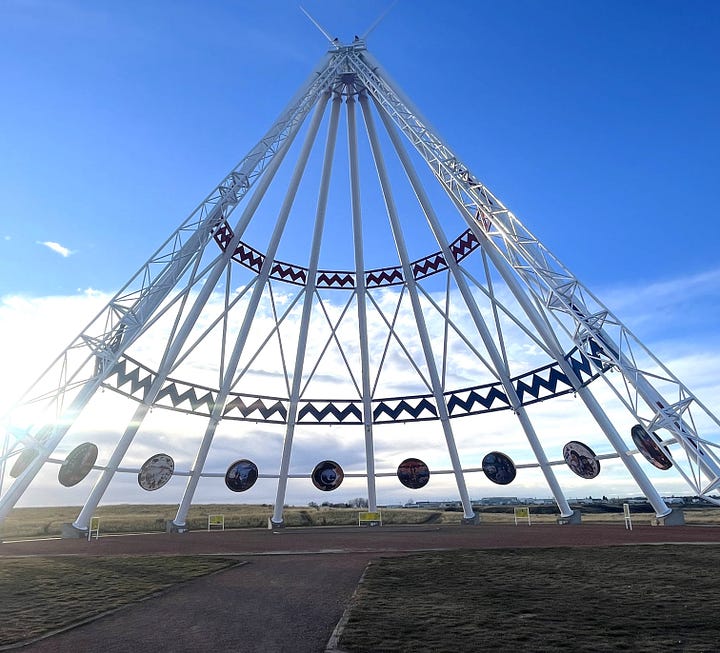
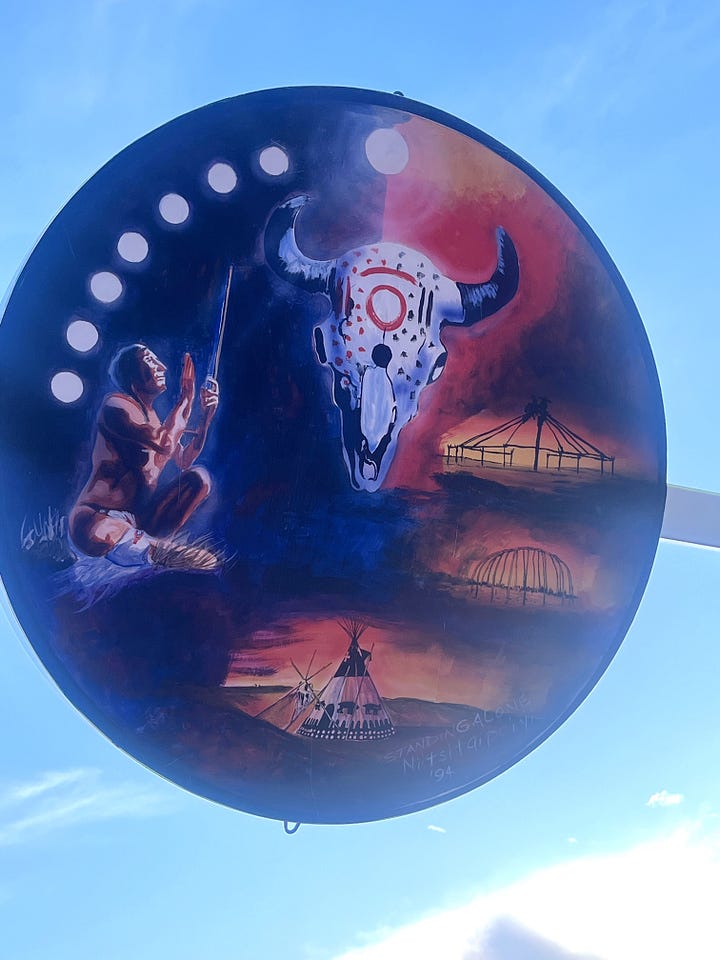
-The “Speak Up” exhibit on Indigenous/Aboriginal Canadian musicians at the National Music Center in Calgary-Alberta, Canada
This was a special room, contemporary and historical at the same time (See Entry #131). I learned about and heard music by Willie Thrasher, an Inuk singer-songwriter who is also an advocate for First Nation social issues, Drezus, a Cree rapper from Calgary, and the world champion pow wow singer Edmund Bull.
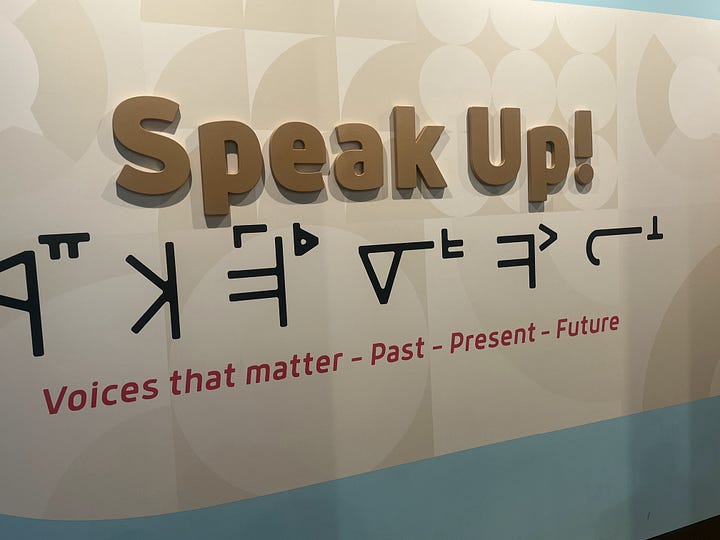
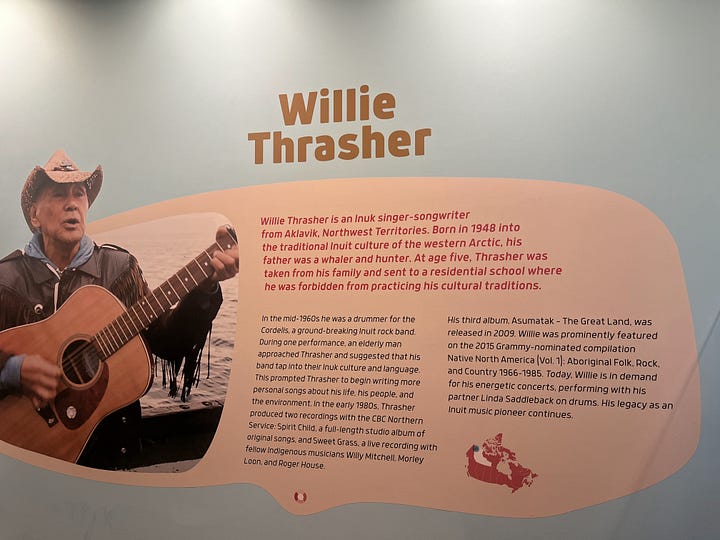
-My “neighbors” at the Springsteen concert in Calgary
There were two guys directly behind me in the GA pit at the Springsteen concert in Calgary’s Saddledome who asked me to take their picture before the show began (See Entry #132). They told me they were proud members of the Athabascan tribe besides being big Springsteen fans. We had a few hours of standing there ahead of us, so we talked a great deal before the concert began. Turns out, they’re big Willie Thrasher fans (see above) too.
-”Indian Country“ sign in Jordan, Montana
It wasn’t a stop sign, but it stopped me cold (See Entry #145). I was on a desolate state highway in Montana, and I was moved to pull over and read about the stone circles called “tipi rings” from the 19th century that can still be seen on these plains. Standing on this cold, wide-open spot, it was easy to imagine a time when Native Americans roamed freely on this landscape as far as the eye could see. Then, as the sign sadly states, “A way of life ended.”
-Crazy Horse National Monument in the Back Hills, South Dakota
I wrote extensively about seeing the Crazy Horse sculpture itself in Entry #146, but the displays of works by contemporary native artists in the Native American Cultural Center in the monument complex were fascinating and inspiring as well. All in all, this was an intense and powerful visit.
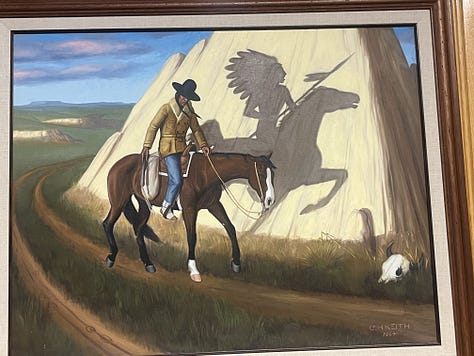

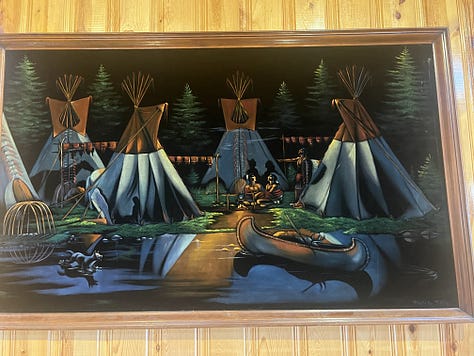
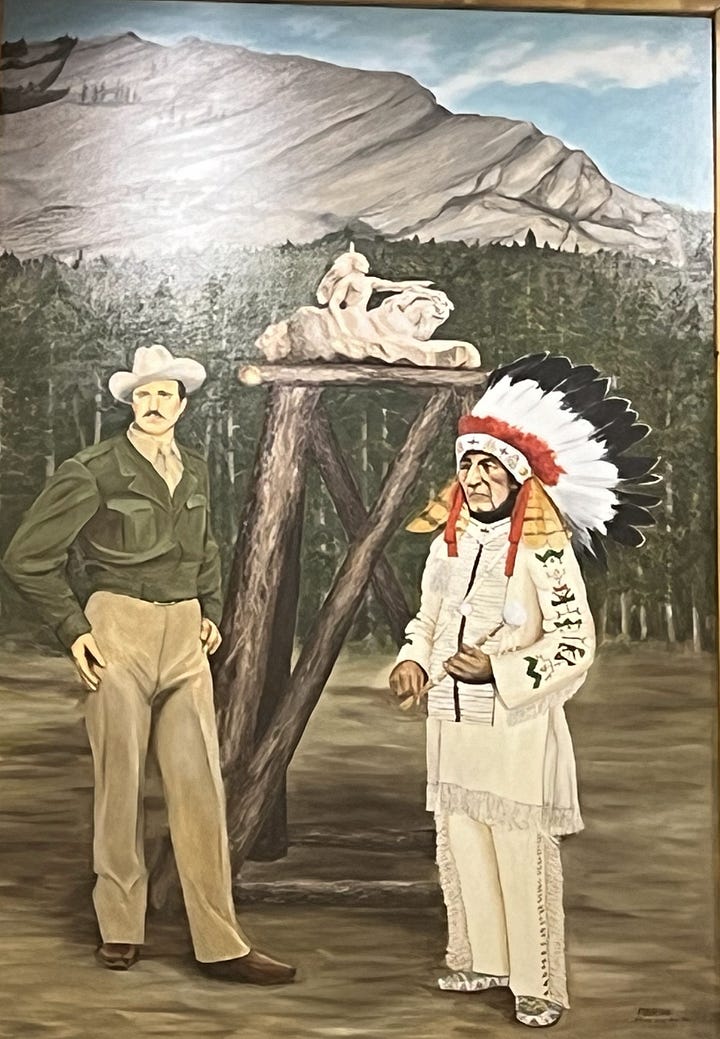
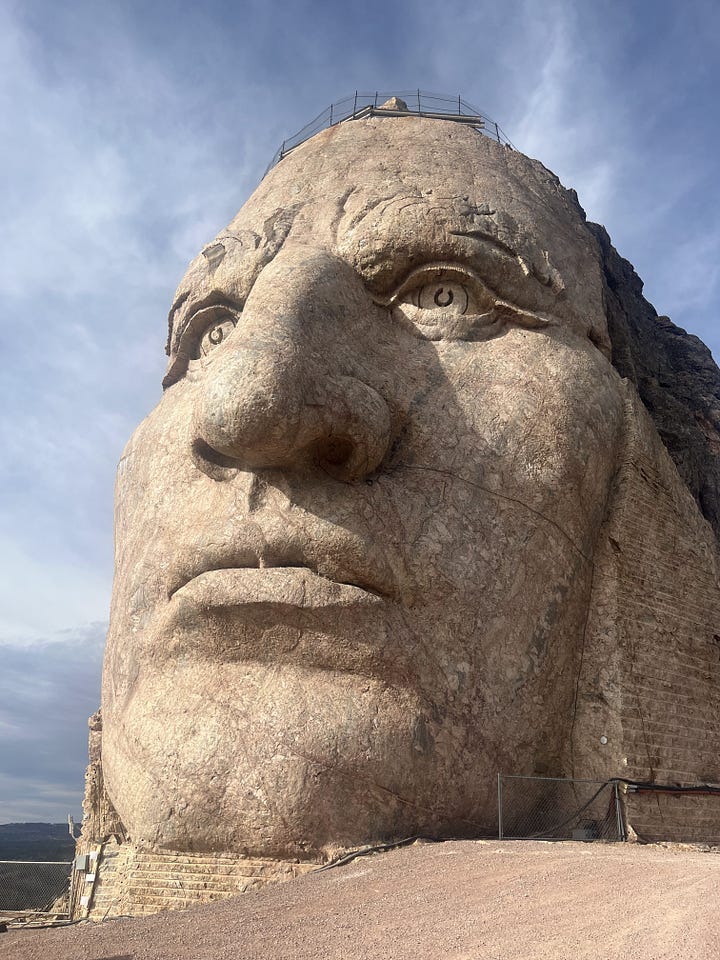
-The Cost of Free Land
Finally, there is the book I was reading along the way. The Cost of Free Land is an excellent piece of historical writing about the very region I was driving through. In the 19th century, the U.S. government offered free “wild” land in South Dakota to families who would come from the east and cultivate it. The author’s great-great grandparents were one of around thirty Jewish families (out of several hundred other families) who had recently fled the pogroms in Russia and came to participate in this homesteading program. There is actually a small part of South Dakota where most in that community ended up that is still called “Jew Flats.” Of course, it became clear over the years that the land in question was taken from Native Americans and part of the wreckage of the treaties our government broke with the area tribes. The book sensitively but powerfully tells the stories of all involved and shines a light on the disturbing reality of one group of oppressed peoples given the chance to start over at the expense of another group of oppressed people. In the name of pursuing justice, proceeds from the book helps fund tribal causes.
Taken all together like this, it feels to me that while catching more of the Springsteen spirit was the main purpose of my Canadian road trip, these Native American encounters were at least a subplot.
Over the course of his career, Bruce Springsteen has written empathic songs from the points of view of alienated factory workers, oppressed Mexican migrants, Black parents frightened for their teenage sons, and more. But, Springsteen has not written any songs about the plight of Native Americans and their struggles over the generations.
However, Springsteen was a guest vocalist on his consigliere Little Steven Van Zandt’s 1987 anthem, “Native American.” (complete with a Lakota chant). Here is a video of the pair playing the song live, and the lyrics appear below.
“NATIVE AMERICAN” BY LITTLE STEVEN FROM HIS ALBUM FREEDOM-NO COMPROMISE
Ho Ka Hey Wah Nah Woh [War Cry of the Lakota Sioux - "Let's Go Now"]
Life was forever when we were young/The land was protected for everyone
Forever as long as the rivers run/But now the water no longer comes And now all that remains/Is darkness and poisoned earth
And now before it's too late/We must provide our own new birthI am Native American
The question of honor you must decide/The soul of the nation has been denied
Our dreams have been stolen before our eyes/How do you say there's no tomorrow to a child? From us there is much to learn/There is so much you've forgotten
You can't change me/Try and understand/I am proud of who I amI am Native American
We must try and remember what we're here for/You will suffer the darkness alone no more
You will have the strength of all of us gathered here today/That is something they can never take awayI am Native American
As I head home to the reality of my post-election nation, I will end with the hopefully prophetic words of Crazy Horse:
“I see a time of Seven Generations when all the colors of humankind will gather under the sacred tree of life and the whole Earth will become one circle again.”
Amen, Aho.
Day 14








This is so well done! 👏👏👏